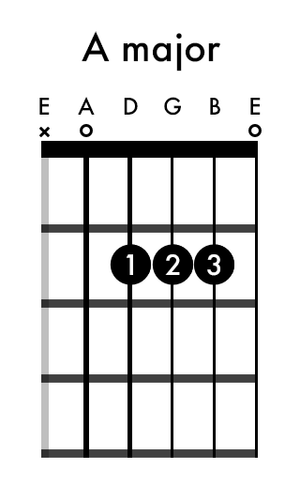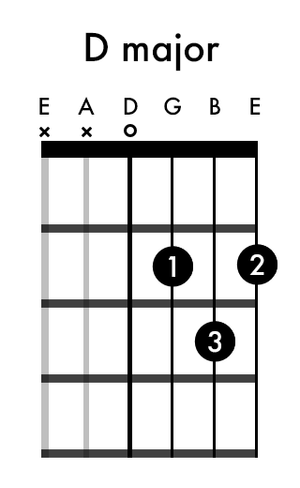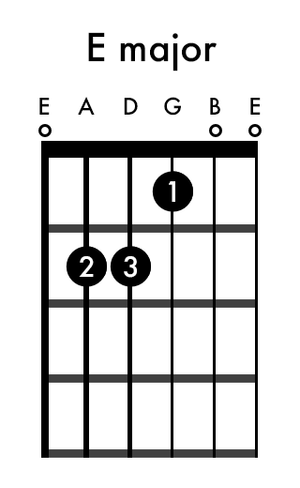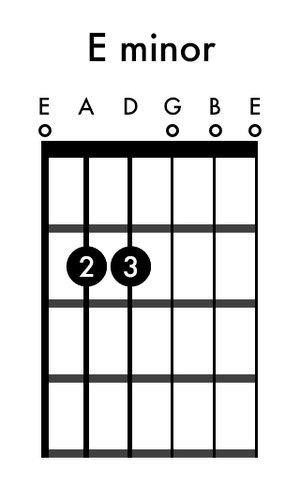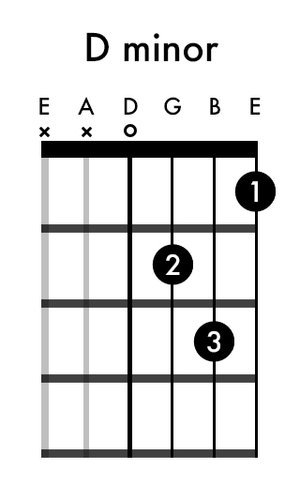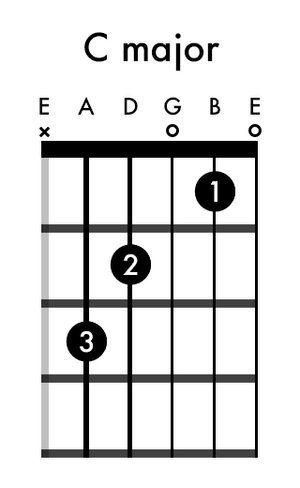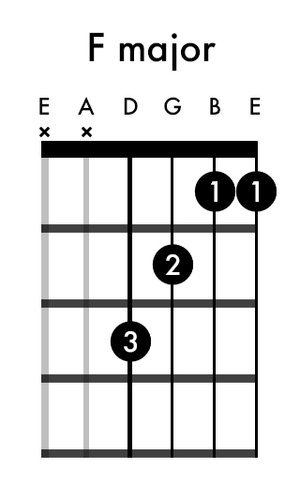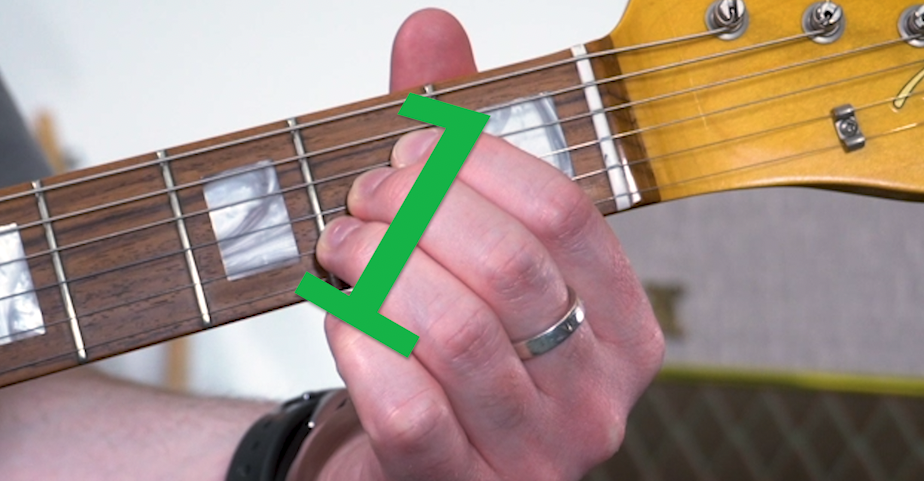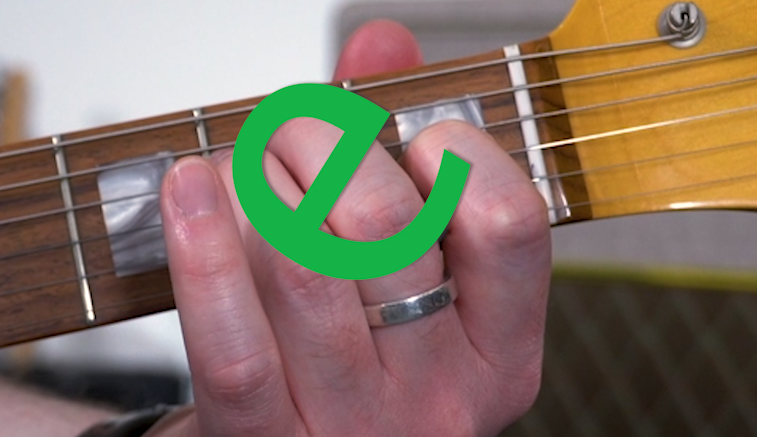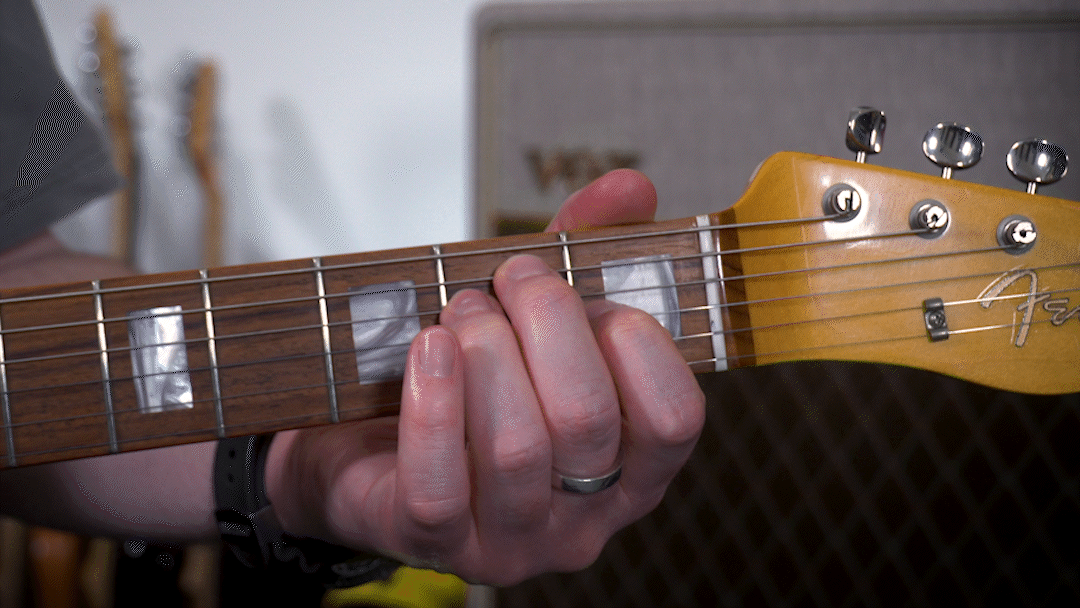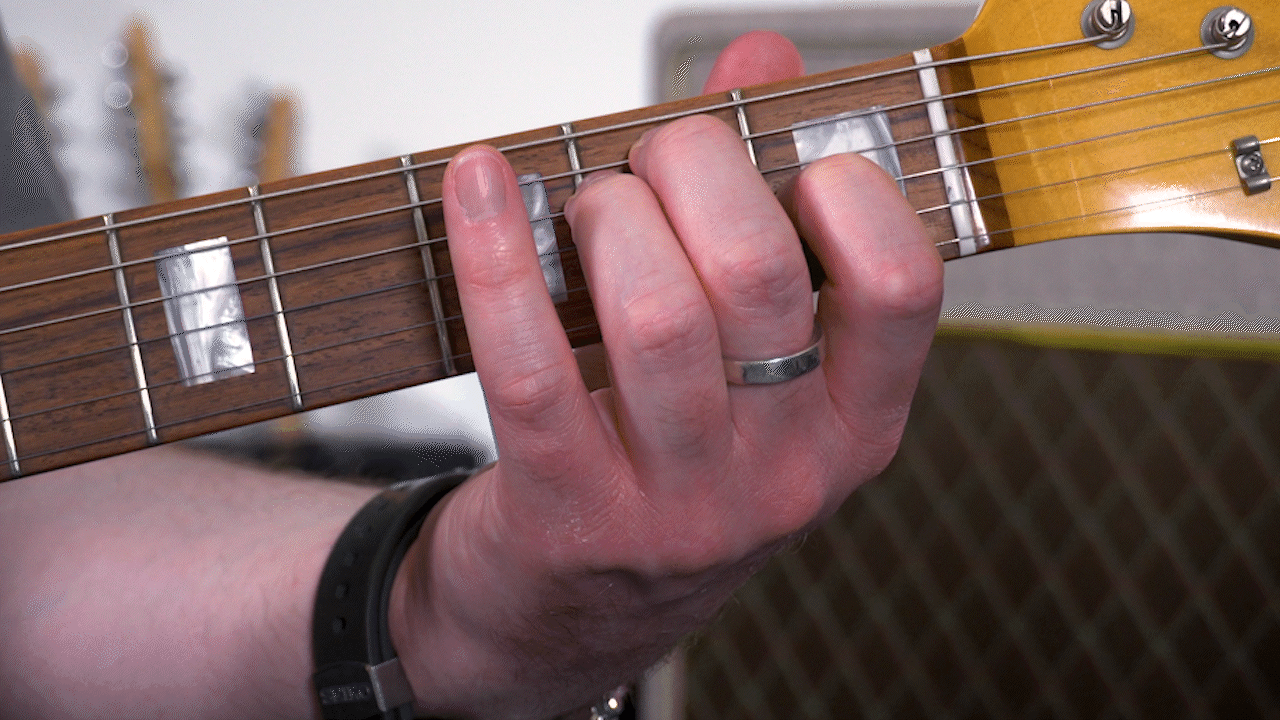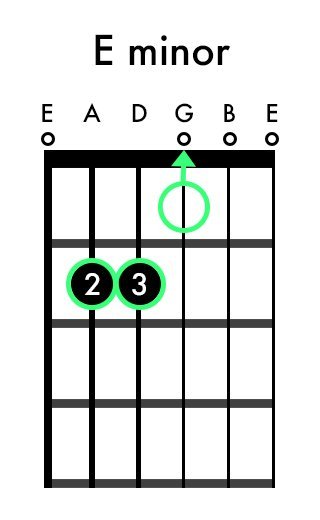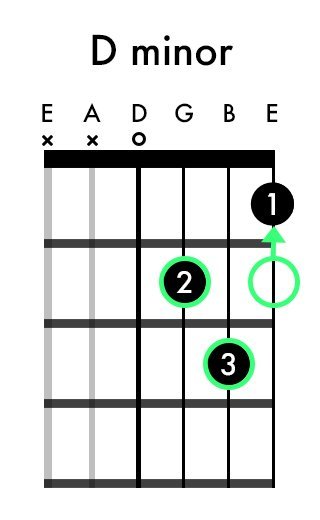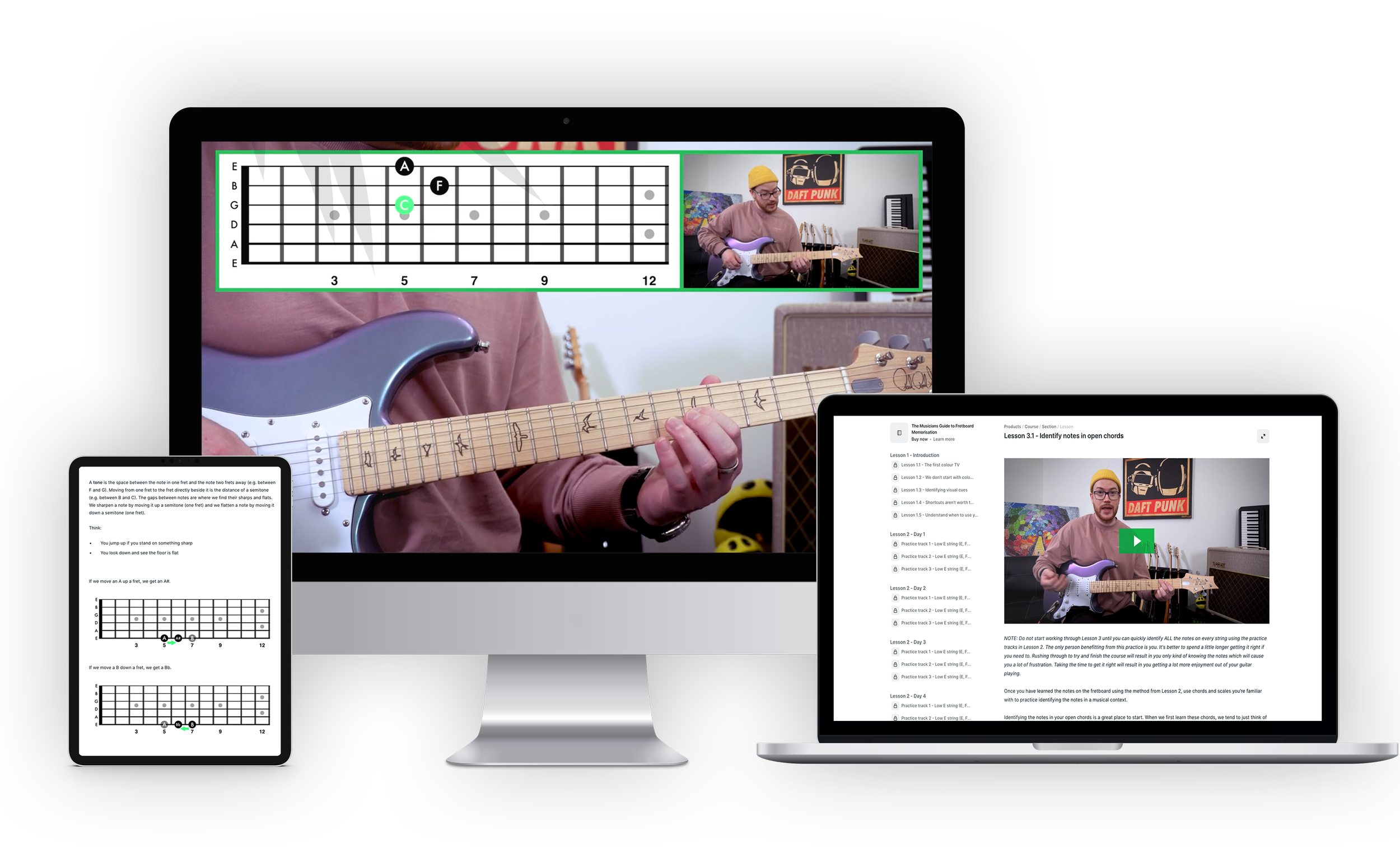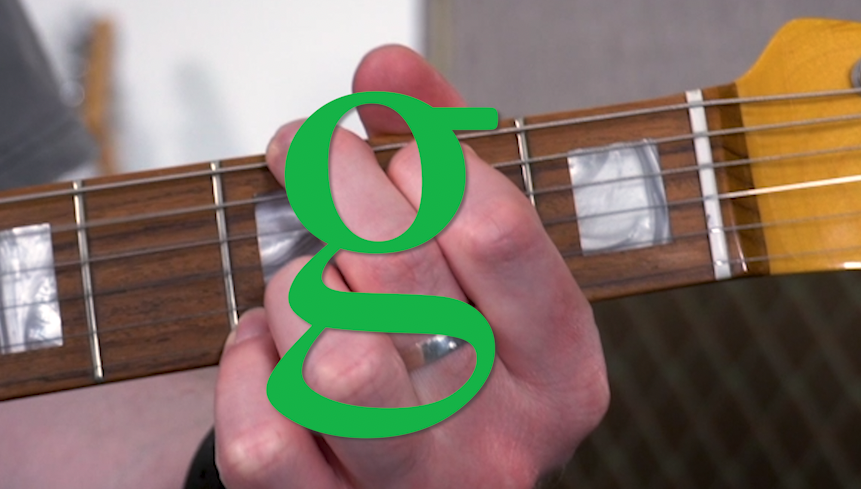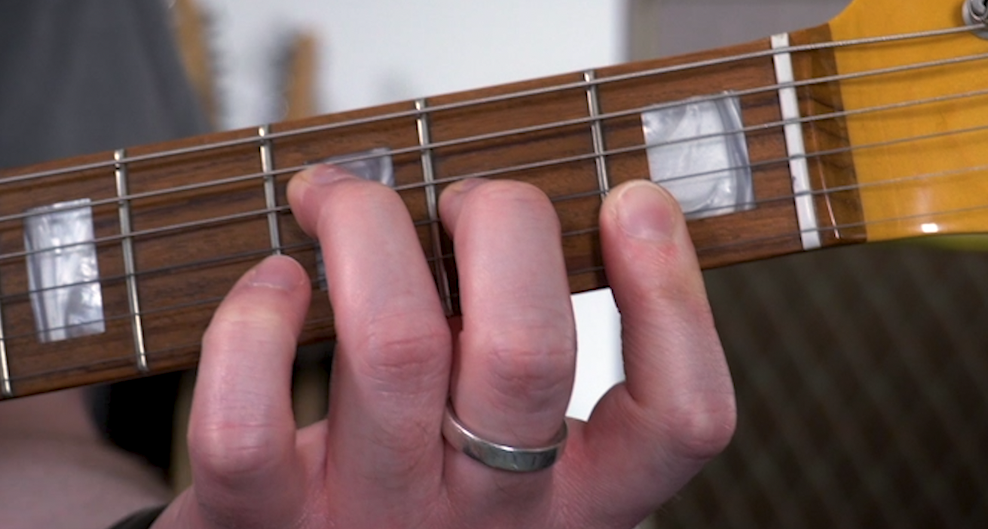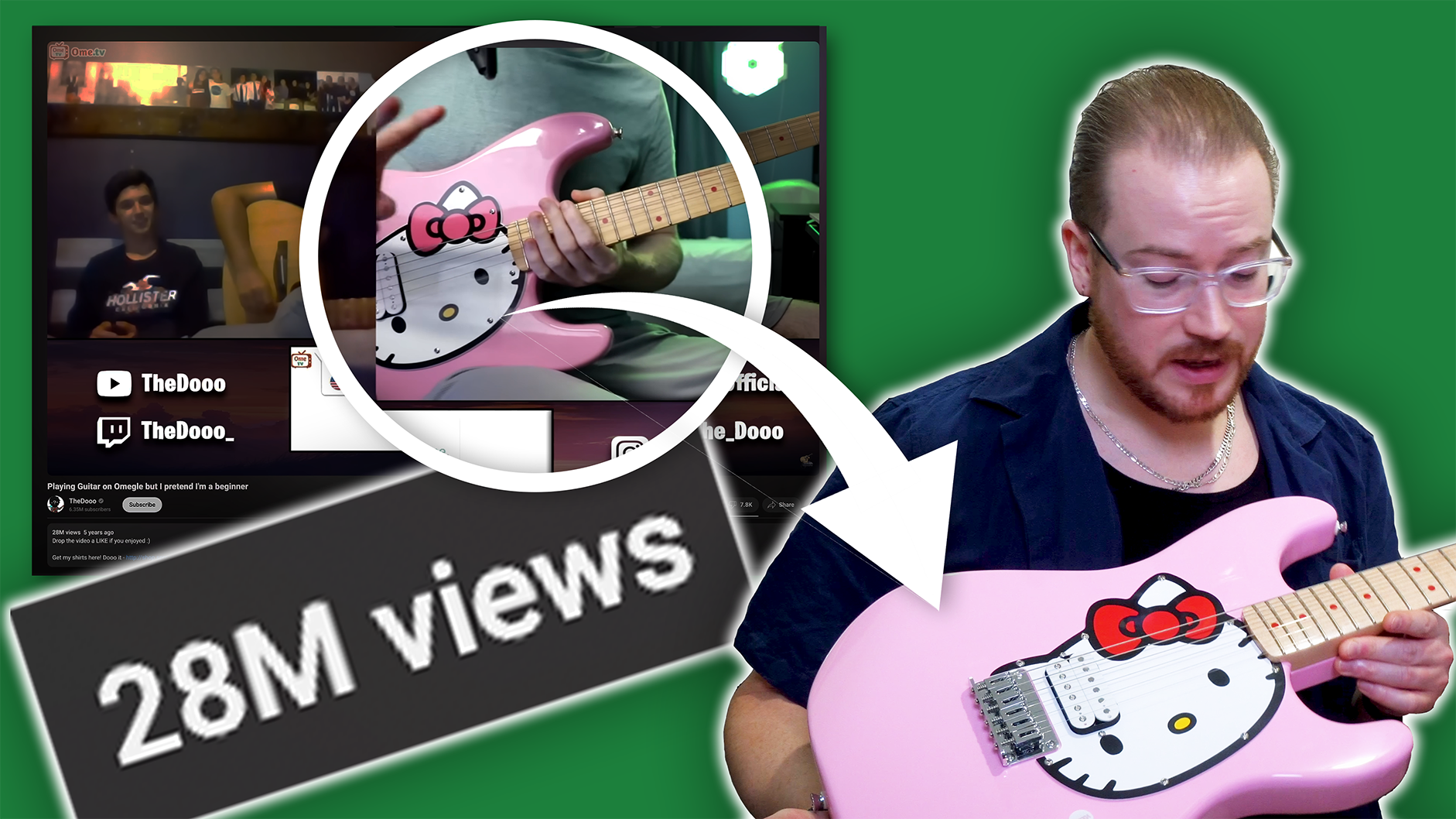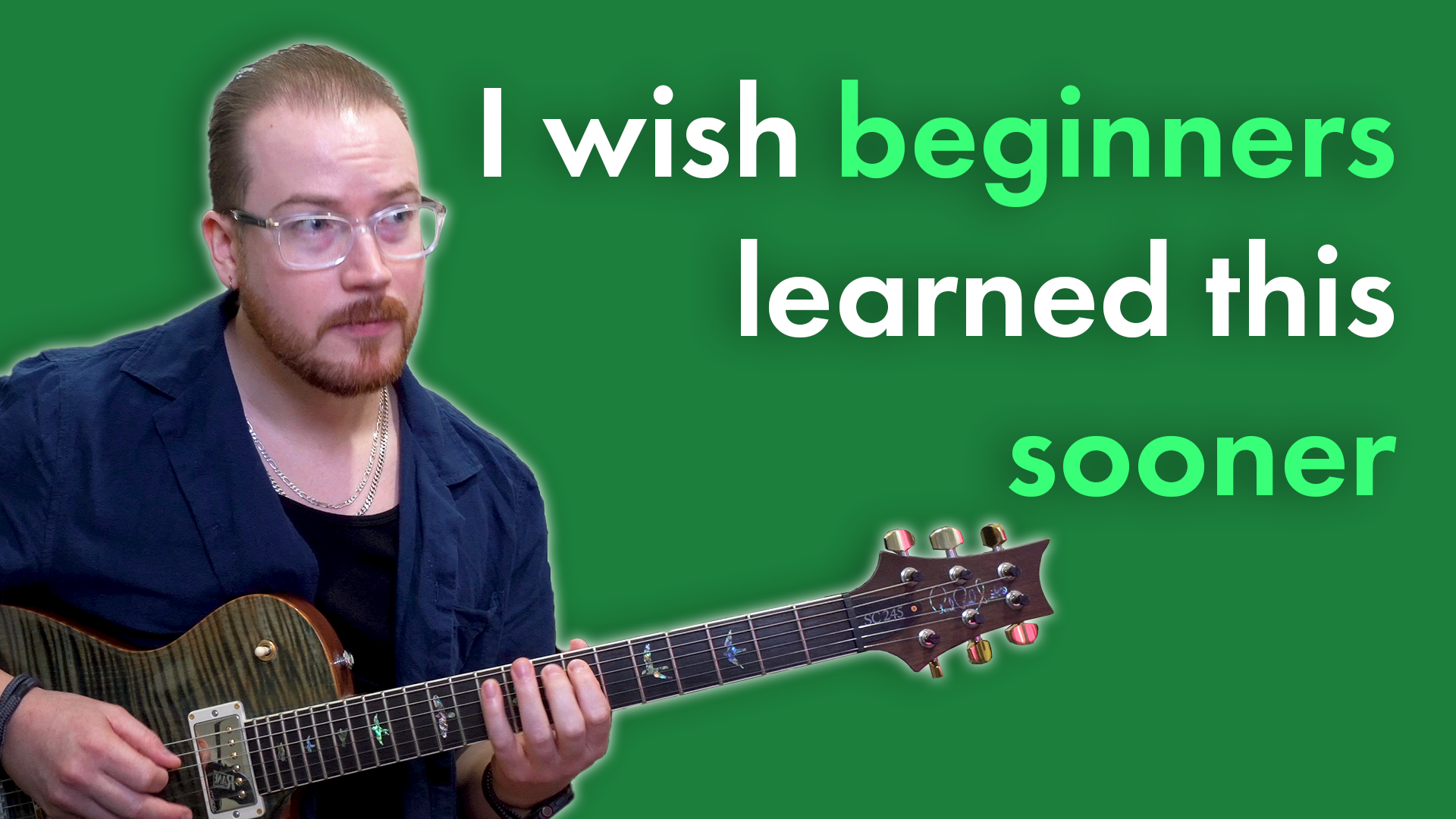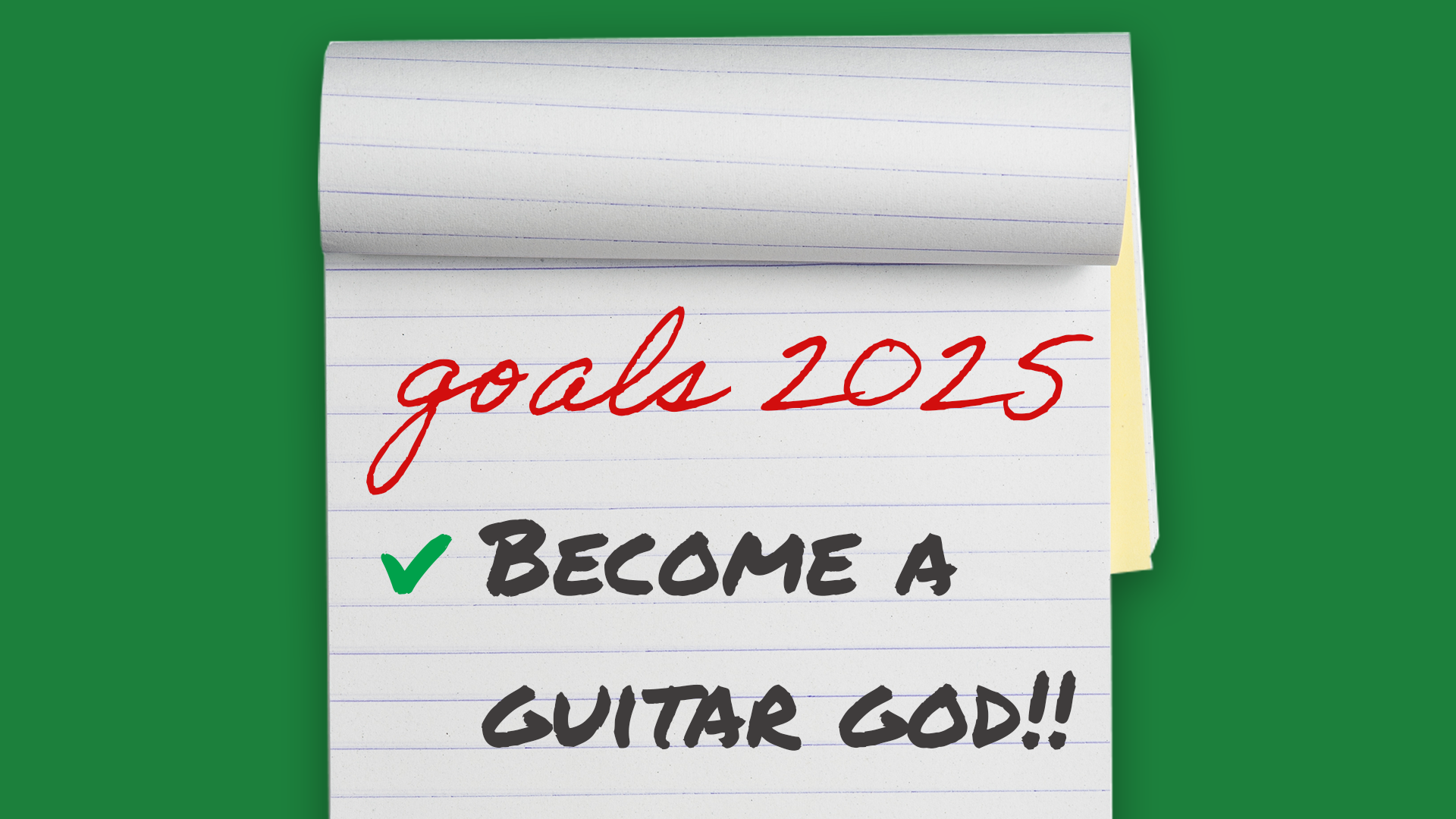Your first 9 guitar chords are easy when you know these tricks
These are the first nine chords you should learn (in this order) when you’re starting out as a beginner guitarist:
In this lesson, you’re going to learn:
Why it’s best to learn them in this order
Some useful memory hooks that will make it easy to remember these new chord shapes
Some songs you’ll be able to start playing immediately with these chords
The game-changing concept most beginner guitar players don’t even know exists
Check out the PDF download at the end of this lesson if you want to print something to keep alongside you while you practice.
The first three chords you should learn on the guitar
There are two reasons why I think you should start with the A, E, and D chords when you are learning to play the guitar:
They are three of the easiest shapes to play on the guitar
They are the I, IV, and V chord in the key of A
These chords are three of the easiest shapes to play on the guitar, but this doesn’t necessarily mean you’ll be able to play them perfectly straight away. There is a certain level of strength and dexterity required to apply the necessary force to the strings and get a good sound. You might find you need to develop this strength and dexterity before the chords start sounding any good and that’s okay. Stay patient. Practice with good technique. You’ll have them down in no time.
The I, IV, and V chords (check out this article to learn about why we use roman numerals to describe chords) are the most important chords in any key and there are plenty of songs that only use these three chords. Starting with these three chords means you’ll be able to find a tune you love and start playing it straight away.
How to get a good-sounding guitar chord
There are three things you need to be doing to play an excellent sounding guitar chord. If you’re doing all three of these things, your chord should sound great. If it doesn’t, go through this list and check that you’re doing each thing correctly.
Three tips for a good-sounding chord:
Press hard to avoid the strings being muted under your fingers
Use the tips of your fingers to avoid muting the strings below
Place your fingers in the best fretting position so you don’t have to push harder than you need to in order to get a good sound
How to play an A major chord on the guitar
I like to think that the shape of the A major open chord looks like the number one and A is the first letter of the alphabet.
A great way to remember which strings to strum is to understand that because A major is an A-type chord, we strum from the open A string.
The reason we do this is due to the fact that the lowest note we hear creates the context in which we hear all the other higher-pitched notes. We want to hear them as an A chord, so we need to hear A as the lowest note. In order to have A as our lowest note, we need to have an open A string. If we understand this, it will be easy to remember that we have to form the shape with our first finger starting on the D string (because we need the A string to remain open).
Don’t worry about trying to maintain an excellent fretting position for your A major chord. Sometimes, it’s physically impossible to achieve a perfect fretting position. In these cases, understanding the other two of our three tips for a good sounding chord will help us compensate appropriately.
How to play an E major chord on the guitar
If you use your imagination, you might be able to see how the shape we form with our fingers to play an open E major chord kind of looks like a lower case ‘e’. It’s possible this analogy is stretching things a little bit, but the point of these memory hooks is to help you notice other little details that will help you remember the shape. Even if you can’t really visualise this lower case ‘e’ scenario, you could still use it as a memory hook. Just think to yourself, “this is the shape some crazy guitarist on the internet said looks like a lower case ‘e’... How on earth did he see that??” Either way, it’s going to help you remember where to put your fingers in order to play an open E major chord.
Remembering our bass note rule from before and how the lowest note we hear gives context to the higher notes; this is an E-type chord, so we’ll need to strum from the low E string.
E major is another example of a chord where we can’t have an excellent fretting position with every finger. In this case, you might notice your second finger sits a little further back in the fret than your third finger. Understanding where we are limited in our ability to demonstrate good fretting position will help us realise where we need to compensate with the other two tips for good sounding chords.
How to play a D major chord on the guitar
One useful way of thinking about the D major chord is to remember that you put two fingers in the second fret and the third finger in the third fret.
I also like to visualise joining the dots of the D shape and noticing they form a capital ‘D’.
Our D major chord is an example of a chord where we can have an excellent fretting position for every finger. If you’re having trouble with this, try rotating your hand slightly clockwise while you’re holding the shape. It’s okay if the side of your knuckle at the base of your index finger touches the fretboard.
-
Here are 20 songs you can play using your A, E, and D chords. Some of the songs will require a capo if you want to play along with the recordings in their original key.
Free Falling - Tom Petty (Capo 8)
Achy Breaky Heart - Billy Ray Cyrus
Bad Moon Rising - Creedence Clearwater Revival(Capo 5)
Blowin’ In The Wind - Bob Dylan (Capo 5)
Born In The USA - Bruce Springsteen (Capo 2)
Chasing Cars - Snow Patrol
The Joker - Steve Miller Band (Capo 8)
I Still Haven’t Found What I’m Looking For - U2 (Capo 4)
The Middle - Jimmy Eat World (Capo 5)
Common People - Pulp (Capo 3)
Hound Dog - Elvis Presley (Capo 3)
The Gambler - Kenny Rogers
I Have A Dream - ABBA (Capo 1)
Johnny B Goode - Chuck Berry (Capo 1)
Mr Tambourine Man - Bob Dylan (Capo 5)
Three Little Birds - Bob Marley & The Wailers
The Tide Is High - Blondie (Capo 2)
What I Got - Sublime (Capo 5)
When Love Comes To Town - U2
You Are My Sunshine - Johnny Cash
How to play an A minor chord on the guitar
One of the cool things we find after playing the guitar for a while is how our learning begins to compound. You’ll notice that the more you learn, the faster and more effectively you’re able to learn! This is one of the reasons why it’s important not to put expectations on yourself when you’re a beginner guitarist in regards to ‘how long something should take to get down’ or ‘how easy something should be’. The compounding effect of your learning means that even if something seems to be taking a frustrating amount of time in the short term, it’s not going to affect your progress overall.
Learning A minor is a good example of this principle in action.
You’ve already learned your E major chord. To play A minor we simply move the entire shape down one string. We can remember this due to our understanding of bass notes. A minor is an A-type chord so we need that open A string in the bass. When we play E major, we’ve got a finger on the A string. So, we need to move the whole shape down to free it up.
It’s important to note that even though we’re using E major as part of our memory hook, the A minor and E major chords are in no way related - we’ll explain why soon.
How to play an E minor chord on the guitar
To play an E minor chord, start with your E major shape and remove your first finger. That’s it. This one is pretty straightforward.
One additional memory hook you could keep in mind is the idea that we are making the shape smaller. E minor. Minor equals smaller. How do we make the shape smaller? By removing one finger.
E minor is an E-type chord so we strum from the open low E string in the bass.
How to play a D minor chord on the guitar
To remember D minor, think about putting your first finger on the first string in the first fret and playing the other two notes of the D major chord.
D minor is quite a stretch. It helps to use the corners of the tips of your fingers to get better reach across the three frets.
D minor is a D-type chord which means we need to strum from the open D string.
What’s the difference between a major and a minor chord?
We have three types of understanding involved when learning the guitar. Our intellectual understanding, our aural understanding, and our physical understanding. Most people only think about the physical aspect of learning a new chord shape. But, it’s just as important to pay attention to how the chord sounds and to try and associate that sound with the physical shape you are playing.
Musicians generally describe major chords as being happier sounding, while minor chords usually sound sadder.
These are not the only emotions you could use to describe these chords. If you play these shapes and they remind you of another feeling, make a mental note of that. It’s not right or wrong, it’s how the chord makes you feel.
Earlier we mentioned that A minor and E major and in no way related, even though they use the same shape. This is just a coincidence and is something that occurs with a number of different chords across the guitar. This is just due to the way the notes are arranged on the fretboard and it’s not really that important. What is important is that we don’t start trying to identify relationships that don’t exist between chords simply because they have the same shape.
When you’re starting out on the guitar it’s not important that you understand the theory behind how major and minor chords are related. However, it is useful to notice that there is a relationship there.
We can see this when we compare the major and minor shapes of each chord type. When we do this we notice that we turn each major chord into a minor chord by simply moving the top finger down one fret.
From this, we can see that there is a specific relationship between the major and minor chords of the same type. But, other similarities between the shapes (like E major and A minor looking similar) are just pure coincidence.
-
Here are five songs you can play using your Am, Em, and Dm chords. Some of the songs will require a capo if you want to play along with the recordings in their original key.
505 - Arctic monkeys
Ain’t No Sunshine - Bill Withers (passing G)
All Of Your Love - John Mayall
Fallin’ - Alicia Keys (Capo 7)
Moves Like Jagger - Maroon 5 (Capo 7)
A Girl Like You - Edwin Collins (Capo 3)
Learning the guitar is not hard - it’s unfamiliar
Recently, I’ve been considering the idea that there aren’t many things on the guitar that are objectively hard. Of course, there are some things. But, I think in most cases, when students say something is ‘hard’, what they actually mean is that it’s unfamiliar. They might not be able to physically do something yet, but this is because they are unfamiliar with the specific movements required to do the thing. Not because it’s hard. Something that is objectively hard is hard whether you’re familiar with it or not.
For example, the F chord (we’ll learn it soon) is objectively hard. It usually takes beginner guitarists some time to get it down and I’m still aware of how difficult it is to change to when I personally play it. Does that mean I have trouble playing it? No. My skills are at a level where I can recognise it as a hard chord and still have no difficulty playing it.
You can develop your skills so things that are objectively hard don’t phase you. It doesn’t mean you have to say they are easy. They’re not. But, as you become an intermediate guitarist and then an advanced player you develop familiarity with the movements required to easily execute these hard things.
I think this is an important concept for beginner guitar players to keep in mind because, when you think something is ‘hard’, you give yourself a reason why you can’t do it. You might think, Maybe it’s just too hard for me. Maybe I’m just not cut out for playing the guitar. This isn’t true. It’s not hard, it’s just unfamiliar. And if it’s only unfamiliar, you simply need to break down what you’re doing into pieces small enough to become familiar with.
That doesn’t mean the process of developing familiarity won’t be challenging and take work. Often, there are other things (such as hand strength and dexterity) that you need to develop along the way. But, there are specific things you can do to work on those. When something is unfamiliar, you can identify specific things that you need to do to develop familiarity. Once you’ve developed the familiarity, it’s done. You can now do the thing fluently. It’s no longer unfamiliar. However, when something is objectively hard, you can develop familiarity and learn to do the thing fluently, but it’s still objectively hard. When something is objectively hard, it never becomes objectively easy. You just become a lot more capable.
Discover how to learn the notes in a way that not only develops your fretboard fluency but reinforces your overall musicianship.
How to play a C major chord on the guitar
Now, we’re getting into chord shapes that require a little more dexterity to play. Don’t worry if you can’t get these straight away. Just as you can’t learn to do the splits overnight, it will take time for your fingers to get flexible.
Our C major chord is similar to D minor in the sense that we want to use the corners of the tips of our fingers to play it. This gives us greater horizontal reach across the fretboard.
If you really want to test the limits of your imagination, you could pretend that someone has taken the letter C and flattened it out. Sometimes I think this chord kind of looks like that. Sometimes I think that’s a terrible analogy. Either way, thinking about that analogy or thinking about how stupid it is will serve as a useful memory hook to remember the shape we need to make with our fingers to play the C major chord.
C-type chords don’t have an open string associated with them. However, we still want the lowest note we hear to be a ‘C’ so it creates the right context for the other notes we hear as we play the chord. In instances like this (where we don’t have an open string associated with the chord), we want to strum from the lowest string that has a finger on it. In the case of our C major chord, this would be the A string.
How to play a G major chord on the guitar
The C major chord requires us to stretch horizontally across the fretboard. We also have to stretch to play the G major chord. But, this time we have to stretch vertically, rather than horizontally.
If you’re still working on developing dexterity, don’t worry if you don’t get perfect clarity for your C and G chords. The process of keeping your ‘tips for a good sounding chord’ in mind and aiming to do all three at once will help you develop strength and dexterity over time.
When you’re starting out, good-sounding chords don’t matter.
Understanding what good technique is and moving in that direction is far more important.
G major is a chord that involves us playing notes on both edges of the fretboard. This means we need to be very intentional about using the tips of our fingers so we don’t mute the open strings in the middle as we play the chord.
When I’m playing G, I like to imagine it looks like a lower case ‘g’. Particularly, in the font shown in the image below.
I also find it useful to note that we have three fingers in the third fret. If we keep this in mind, I find it’s fairly easy to ‘fill in the gap’ with the first finger in the second fret on the A string.
The four-chord song allows you to play (almost) everything
The I, V, vi, IV is sometimes known as the four-chord song and it’s one of the most common progressions in pop music.
We can play this progression starting on the I chord (the G in this case):
Or the vi chord (the Em in this case):
Many songs will use this progression for a section of the song or even just loop it up for the whole thing!
-
Here’s a list of songs we can play using the I, V, vi, and IV chords in the key of G. Some of the songs will require a capo if you want to play along with the recordings in their original key.
What’s Up - 4 Non Blondes (Capo 7)
Thrash Unreal - Against Me (Capo 10)
Be With You - Akon (Capo 2)
Sweet But Psycho - Ava Max (Capo 6)
Complicated - Avril Lavigne (Capo 10) Uses ii
Everybody Hurts - Avril Lavigne (Capo 3)
Nobody’s Fool - Avril Lavigne (Capo 9)
Remember When - Avril Lavigne (Capo 5)
What The Hell - Avril Lavigne (Capo 2)
Pompeii - Bastille (Capo 2)
Stand By Me - Ben E. King (Capo 2)
Sangria - Blake Shelton (Capo 2)
Dammit - Blink 182 (Capo 5)
Maria - Blondie (Capo 2)
Summertime - Bon Jovi
Whiskey Lullaby - Brad Paisley
Beat Of The Music - Brett Eldredge (Capo 2)
Just The Way You Are - Bruno Mars (Capo 10)
Marry You - Bruno Mars (Capo 3)
Call Me Maybe - Carly Rae Jepson
Lost - Coldplay
Have You Ever Seen The Rain - Credence Clearwater Revival (Capo 5)
Save Tonight - Eagle Eye Cherry (Capo 5)
Perfect - Ed Sheeran (Capo 1)
Photograph - Ed Sheeran (Capo 9)
Burn - Ellie Goulding (Capo 6)
Wonderful Tonight - Eric Clapton
Work From Home - Fifth Harmony (Capo 1)
Young Blood - Five Seconds of Summer ( Capo 3)
Shotgun - George Ezra (Capo 10)
Cruise - Florida Georgia Line (Capo 3)
Time Of Your Life - Green Day
Sign Of The Times - Harry Styles (Capo 10)
Let Her Cry - Hootie and the Blowfish
Collide - Howie Day (Capo 4)
Demons - Imagine Dragons (Capo 6)
Replay - Iyaz (Capo 2)
Impossible - James Arthur (Capo 8)
Say You Won’t Let Go - James Arthur (Capo 3)
Love Yourself - Justin Bieber (Capo 9)
What Ifs - Kane Brown (Capo 3)
Not Pretty Enough - Kasey Chambers (Capo 4)
Cop Car - Keith Urban
Die Young - Kesha (Capo 9)
Million Reasons - Lady Gaga (Capo 5)
I Like Me Better - Lauv (Capo 2)
Bleeding Love - Leona Lewis (Capo 10)
Castle Of Glass - Linkin Park (Capo 9)
The Messenger - Linkin Park
Rude - Magic (Capo 6)
She Will Be Loved - Maroon 5 (Capo 8)
Payphone - Maroon 5 (Capo 4)
Don’t Wanna Know - Maroon 5
Animals - Maroon 5
In The Name Of Love - Martin Garrix
Down Under - Men At Work (Capo 7
Apoligize - One Republic (Capo 8)
If I Lose Myself - One Republic (Capo 7)
Hey Ya - Outkast
Good Time - Owl City (Capo 8)
Perfect - Pink
Try - Pink (Capo 7)
Fight Song - Rachel Platten
Don’t Forget Me - Red Hot Chili Peppers (Capo 5)
How To Save A Life - The Fray (Capo 3)
Hey Soul Sister - Train (Capo 9)
With Or Without You - U2 (Capo 7)
Brown Eyed Girl - Van Morrison
Riptide - Vance Joy
You’re Beautiful - James Blunt (Capo 8)
I’m Yours - Jason Mraz (Capo 4)
Wherever You Will Go - The Calling (Capo 7)
How to play an F major chord on the guitar
The F major open chord shape is objectively hard. In order to play this chord, we need to have developed some independence of movement between our fingers. This is the first time most guitar players will have tried this kind of independent movement. Your first finger needs to be pushed flat against the fretboard, with the knuckle bending back the way it doesn’t naturally go. While you’re doing this, you also have to have the second and third fingers nicely rounded and use the corners of the tips of your fingers. It’s hard. It’s also worth taking the time to get right because it’s a super useful shape that you can do some really cool stuff with.
Take your time with F. Focus on understanding the technique required to play the chord and doing it properly. The clarity will come with time.
Don’t be tempted to take shortcuts that might give you a better-sounding chord in the short term.
Unfortunately, these shortcuts will end up limiting your progress long term.
I usually suggest students start with the second and third fingers. Just like we did with C and Dm, we want to use the corners of the tips of our fingers for good reach. Once we’ve got the second and third fingers in position, we can pull our first finger in, pushed flat across two strings with the knuckle bending back the way it doesn’t naturally go. Think of it like you’re squeezing the fretboard between your index finger and your thumb. Your thumb should always be halfway down the back of the neck when you play this chord.
It might take a long time to get a good sound out of your F chord. But, as long as you’re moving in the direction of good technique, you will be developing the strength and dexterity needed to play a good-sounding F chord. The clarity will come with time.
Now that you’ve learned how to play your F major open chord, you can play the I, V, vi , IV progression in the key of C.
Or you can start on the vi chord.
The open chords available to us in the keys of C and G and the most useful open chord shapes on the guitar. If you have a capo and you know how to use these shapes, you’re pretty much equipped to play any song in any key!
This is particularly useful as some of the capo recommendations for playing the songs in the key of G are a little impractical. Using our C shapes will allow us to play them with a much more sensible capo position.
Understanding the concept of mental bandwidth will change how you learn guitar
Getting your head around this idea will save you a lot of the frustration I’ve seen students experience when they think they are doing something wrong but are actually not.
Mental bandwidth is the idea that we only have so much attention to allocate to anything at any given time.
If we focus on one aspect of our playing, we might miss something happening elsewhere. Increasing the number of things we have to be aware of diminishes the amount of focus we have available for each. If we raise the stakes by speeding up our playing, we reduce the amount of focus we have available overall.
You might have noticed that practising our chords for the first time requires all our mental bandwidth. We’ve got the tips for a good-sounding chord and all our memory hooks; there’s a lot to think about. But, that’s okay. When you’re learning something new, you want to be able to apply all your focus to make sure you’re doing it right.
Eventually, you’ll want to start playing some songs and this will split your focus. Now, you’re going to have to think about your right hand and your strumming. You might only have 20% of your mental bandwidth available to focus on playing good-sounding chords. If you still need 100% of your attention to play these chords clearly, but you only have 20% available... It makes sense that your chords are going to sound a little worse for wear with the majority of your focus allocated to your right hand.
A lot of students experience this and think they’ve started making backwards progress with their chords. They used to be able to play them so well! This causes frustration and discouragement. But, what these students don’t realise is that it’s simply a mental bandwidth issue.
When you’re trying something new with your right hand, that’s where your attention should be. Understanding how the concept of mental bandwidth interacts with your playing will help you practice more strategically and avoid the frustration and discouragement many students face because you’ll know you haven’t made backwards progress. You’ve just allocated your mental bandwidth elsewhere. It’s okay if you’re chords sound average while you’re working on your strumming.
As you spend more time on the guitar, you’ll notice the amount of mental bandwidth needed to play the instrument significantly decreases! It won’t be long before you only need 50% of your focus to play good sounding chords and 50% of your focus to strum. Everything will start to come together. Then you’ll be able to do each of these things with only 25% of your focus.
Now you’ve got some spare mental bandwidth available, maybe you could start learning to sing and play at the same time?

